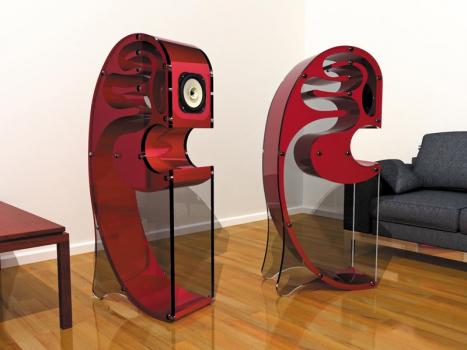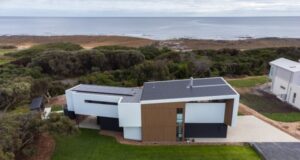
That ‘smaller is better’ has been pushed to end-users for decades, but now a Sydney company is going large – very large.

Over the years the audio industry has been taken over by smaller, sleeker, more efficient speakers. Recent technological advancements have led to a raft of older audio technologies being left behind, such as the horn speaker.
However, one man is refusing to let its legacy die.
Creation Audio owner Andrew Tilsley is an audiophile with an appreciation of the clear, warm sound of the back-loaded horn speaker – something he feels conventional modern speakers simply can’t match.
“When you hear a horn speaker, compared with a conventional speaker, there is a particular dynamic to the sound,” Andrew says. “Their accuracy, detail and sound stage can’t be beaten by a conventional speaker, unless it is very good or very expensive.”
Creation Audio is a Sydney custom manufacturer of horn speakers. It is one of the few manufacturers remaining and it offers basic to high-end, complex sound systems, as well DIY ‘flat pack’ kits for enthusiasts. The C-Horn speaker is Creation Audio’s signature design that features a carefully rounded horn path to provide a bigger, more efficient and more solid sound.
The C-Horn is a single eight-inch (20cm) driver back-loaded horn. It is fairly imposing at 1.4m tall but has a relatively narrow footprint of about 35cm. The side panels of the speaker are constructed from 25mm transparent acrylic, which grants visual access to the complex moulded inner workings. These can be finished in different colours or types of hardwood to give the speaker an unusual appearance. More important, the inner workings are what give the C-Horn its distinct sound.
“Over the past few years I’ve developed a real interest and love for this type of speaker, but what I’ve found is that the manufacturing process is quite tricky,” Andrew says. “As such, I have developed a very simple yet advanced method of manufacturing the complex horn internals.”
“As the sound wave expands, you need a horn path that can handle the larger bass response. So you need a longer horn and a larger mouth opening. The smaller the mouth, the more impact it has on reducing the bass, so there has to be a compromise as technology goes smaller and smaller. To get around this, some people augment the bass with a powered sub-woofer, but I’ve tried to take a purist approach and retain the single driver.”
Depending on the chosen driver, the efficiency of the C-Horn can be quite high. The standard driver is a Lowther, which operates at 96-98dB efficiency. In comparison, a normal speaker available at a local hi-fi retailer operates at 88-89dB efficiency. Andrew says this illustrates how efficient the C-Horn is, and a valve amp of 3-4W would be more than enough to drive the speaker.
“The traditional speaker needs a moderate or high-powered amplifier to run it. However, in most instances a horn speaker – connected to a low-powered, high-quality amplifier – results in a very efficient sound. Using low-powered amps also opens the door to using valve amps, which offer a lovely warm sound.”
The advanced manufacturing process involves designing the unit on a computer. The plans are then sent to a machining company, which cuts out the internal horn from MDF. Then it’s back to Creation Audio, which assembles the complete unit. Andrew says this method allows big time savings in the manufacturing process. It takes only three days to finish a job that would take three months using traditional methods.
The C-Horn’s inner workings are often made entirely of MDF, a material Andrew says is not very pleasant to work with.
“But the internals are so dense, and the horn path is so rounded and smooth that the sound travels very well through MDF. It offers the best value for money and ease of assembly for the builder. Because we are a custom builder, we can accommodate most people’s requests. But in most cases, because of cost, the MDF works well.
“All the big speakers I’ve sold have been MDF, and I’ve had no complaints.”
Andrew says Creation Audio intends to market the speakers as a niche product to fans of the horn concept who want to continue using such speakers in their systems. However, he does not intend to limit the company to this customer group.
“Because of the modern and advanced manufacturing process, I’m hoping to target people who may already have good-quality drivers in fairly plain boxes. We will provide the cabinets without drivers to attract that particular market.”
With its straightforward assembly method, the horn speaker is also aimed at the DIY market. The wooden slices that come in the kit have computer-cut dowel holes, which means alignment and assembly is a relatively simple task.
DIY enthusiasts do need some basic understanding and experience of gluing and clamping to put the unit together. Also, the finishing aspect requires some skill, because sanding or routing tools are used.
The DIY packs contain the internal horn slices, which aren’t assembled, along with pre-cut dowels and photo instructions.
Despite the C-Horn’s large size, Andrew believes it lets people explore what they want to get out of their music.
“Something like the C-Horn is aesthetically pleasing like no other speaker in the world. Depending on the colour choice, or whether the internals are made of varying hardwoods, it can create an exotic talking point in any room while producing a world-class sound output.”


